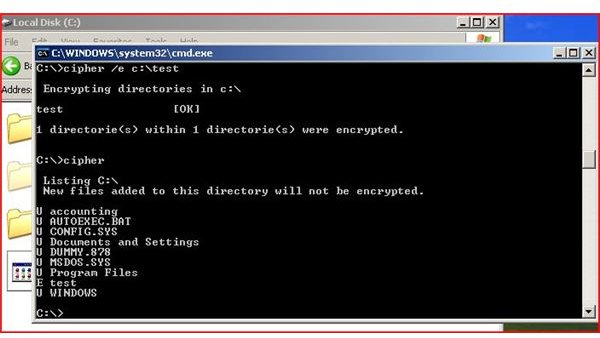

- #CIPHER CMD C DRIVE W HOW TO#
- #CIPHER CMD C DRIVE W WINDOWS 10#
- #CIPHER CMD C DRIVE W PC#
- #CIPHER CMD C DRIVE W FREE#
Step 3: Follow the instructions of the selected unlock method and click Next button to move on. Lastly, modify the options as like the following window. Then navigate to the path 'Computer Configuration > Administrative Templates > Windows Components > BitLocker Drive Encryption > Operating System Drives' and double-click Require additional authentication at startup in the left pane. Note: When you BitLocker encrypt the Windows partition with TPM, its unlock options can be shown after configuring the settings below: Open Local Group Policy Editor firstly. Step 2: Choose the wanted unlock method in the shown wizard.
#CIPHER CMD C DRIVE W PC#
Step 1: Access This PC and right-click the C drive to choose Turn on BitLocker option. Part Two: Encrypt C Drive with BitLocker 1. You are suggested to backup the C drive in case that the system partition is damaged caused by unexpected accidents or wrong operations during the BitLocker encryption process. If there is not, you have to make some settings to allow BitLocker without a compatible TPM.ģ. If there is a TPM chip on your PC motherboard, please remember to enable it.

#CIPHER CMD C DRIVE W WINDOWS 10#
Make sure that your operating system is Pro, Enterprise or Education editions of Windows 10 which supports the BitLocker encryption.Ģ. Part Two: Encrypt C Drive with BitLockerġ.
#CIPHER CMD C DRIVE W HOW TO#
So, how to encrypt the C drive with BitLocker in Windows 10? This post will give you the detailed answers in the following part.
#CIPHER CMD C DRIVE W FREE#
With the help of BitLocker, your C drive can be effectively free of unauthorized access so that its data and your OS is strongly protected. If you are going to encrypt the Windows partition(C drive) on your computer, then BitLocker Drive Encryption must be a useful utility for you. Some vendor's SSD drives will come with a vendor-specific implementation of secure erase.How to Encrypt C Drive with BitLocker in Windows 10 However PartedMagic does implement secure erase. Secure erase implementations are available for Linux and there are many tutorials: SSD Secure Erase and SSD memory cell clearing.Īn overview of secure erase for windows is available. This is also secure, in that data recovery services will not be able to recover the data. This saves the drive from the additional damage of extra write operations. This erase method, instead of over-writing the memory cells, will tell the SSD to mark every memory cell as clear. The secure erase is a method that tells the SSD to clear all the memory cells simultaneously. Not every drive and not every operating system supports this. There is an ATA Secure Erase specification for SSD drives. It is not currently accepting new interactions. There are disputes about this answer’s content being resolved at this time. I've looked at some other answers, but they seem ~3 years old and I know things might have changed in that time. I considered using dban, but right off the bat it says: I'm a little confused as I've read conflicting information as to whether or not these "eraser" type methods are needed anymore with TRIM-enabled SSDs (which I'm guessing mine is).īasically I'm deleting a bunch of old data before a laptop gets sent to the charity bin, and just wanted to do it the best way possible since I have no idea who's using it next. When running it, I see it taking 20 minutes to write 0x00, another 20 writing 0xFF, then a good deal longer writing random numbers (all via the command prompt). Volume, it might take a long time to complete and should only be used Because this option writes to a large portion of the hard Other programs can obtain space on the drive, which cipher cannotĮrase. w removes data from portions of the volume it can access and have notīeen allocated to files or directories. I've used Eraser in the past, and recently became aware of the cipher command in Windows 8.


 0 kommentar(er)
0 kommentar(er)
